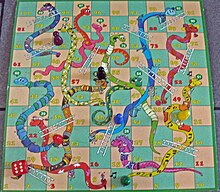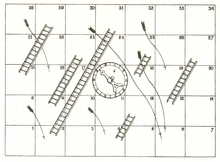Ladder game
The ladder game or snakes and ladders (in English: Snakes and Ladders , in Switzerland: Ladder game ; sometimes also funny ladder game ) describes a family of board games that are based on the traditional Indian game Moksha Patamu . If Moksha Patamu still had a religious meaning, it has completely disappeared in the western versions. Today it is widely used in numerous variants, especially as a children's game .
Gameplay
A ladder game board contains a chain of playing fields, which leads from a start to a finish field and winds in a spiral or zigzag. In several places two not directly consecutive fields are connected by snakes, ladders or other drawings.
Each player begins with a pawn on the starting field. Usually a single die is thrown in turn . Its result indicates how many squares the pawn can move forward. If your turn ends on the starting space of a ladder, it is advanced to its end space. If it ends on a snake, it is moved to its end space, which is closer to the start space. The winner is whoever reaches the target field first.
In detail there are different rules for reaching the target square with pinpoint accuracy or the situation that the end square of a movement is already occupied by another figure.
variants
The game is in its basic form a pure game of chance without strategic elements, which is why it is mainly played by and with younger children. In the English-speaking world, the original ladders and snakes have remained widespread as images on the board, presumably due to the still common name of Snakes and Ladders . In the German-speaking area, on the other hand, there are fewer queues, but more alternatives such as slides . There are countless variants of the game board with different lengths, numbers and positions of abbreviations and graphic design, often with colorful backgrounds and thematically adapted abbreviations.
The basic principle of the game is also often modified, for example each player is given several pieces or special events are assigned to individual fields (move forward 3 fields, suspend a round ...). The ladder game is also a popular basis for educational games that set a thematic background or incorporate knowledge questions .
history
The first western ladder game was launched in 1892 by the toy company of Frederick Henry Ayres in England with a circular game board. In a clockwise direction, the pieces had to be moved to the middle. The game had a total of 100 fields on which five snakes and five ladders were drawn.
RH Harte developed a variant on a rectangular playing field in 1893. In the same year there was a patent for a similar rectangular game board that only contained 34 individual fields.
Around 1920, Spear & Sons released a game called “Up and Down! Funny ladder game ”. There were no more snakes on the board here, but rather circus scenes with the same function.
Mathematical analysis
In the standard rules of the ladder game, there is no decision-making option for the players, nor any interaction between the players. Therefore, the average number of throws it takes to reach the goal can be determined empirically in a series of tests performed by a single player. The results of a Monte Carlo simulation were published in 1960 for the version marketed by Milton Bradley . This resulted in an average of 39,420 throws to the target in 16,384 attempts.
The mentioned publication also describes the way to obtain the mentioned result without simulation in the context of a calculation. For this purpose, the ladder game is modeled by an absorbing Markov chain with 100 states that correspond to the playing fields. On this basis, the expected value 39.224 of the required number of litters is calculated.
See also
Web links
- Schedule Snakes and Ladders in the version distributed by Milton Bradley, as it is the basis of the mathematical analysis of Bazley and Davis, in the English language Wikipedia.
Individual evidence
- ↑ a b c Erwin Glonnegger : The games book . Ravensburger Buchverlag, Ravensburg 1988, ISBN 3-473-42601-6
- ^ David Parlett: The Oxford History of Board Games . Oxford / New York 1999, ISBN 0-19-212998-8
- ^ A b N. W. Bazley, PJ Davis: Accuracy of Monte Carlo methods in computing finite Markov chains . In: Journal of Research of the National Bureau of Standards - Mathematics and Mathematical Physics , Volume B64, 1960, pp. 211-215.
- ↑ Jörg Bewersdorff : Luck, Logic and Bluff: Mathematics in Play - Methods, Results and Limits , 7th edition, Springer Spectrum, 2018, ISBN 978-3-658-21764-8 , pp. 68-69, 75, doi: 10.1007 / 978-3-658-21765-5 . SC Althoen, L. King, K. Schilling: How long is a game of Snakes and Ladders? In: The Mathematical Gazette , Volume 77, No. 478, March 1993, pp. 71-76, doi: 10.2307 / 3619261 .


